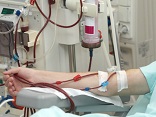Comparison of HemoFoam® and Conventional Gauze Dressing on Hemostasis of Vascular Access Site in Hemodialysis Patients
DOI:
https://doi.org/10.31661/gmj.v8i.1395Keywords:
Hemodialysis Patients, Hemostasis, Hemostatics, Bandages, Arteriovenous FistulaAbstract
Background: Dialysis access puncture wound bleeding after needle extraction at the end of each hemodialysis session is a very important problem. This study evaluated the effect of HemoFoam® compared to conventional gauze dressing on hemostasis of dialysis access puncture wound bleeding in hemodialysis patients. Materials and Methods: This one-group, before-after, clinical-trial was conducted on 60 hemodialysis patients selected by convenience sampling who underwent hemodialysis through arteriovenous fistula in Shahid Rahnemoon Hospital, Yazd, Iran in 2017. After reviewing the eligibility criteria, the study was performed in two separate sessions. In the first session, only HemoFoam® was used while in the second session; the only conventional dressing was used. Time of hemostasis in each puncture wound was evaluated. Data were analyzed by SPSS 22 (IBM SPSS Statistics for Windows, Armonk, NY: IBM Corp, United States) using paired T-test and Chi-square tests. Results: The mean age of the patients was 55.20±14.25 years. Hemostasis was achieved in 76.6% of cases at the arterial access site in the first two minutes in the HemoFoam® group. The mean homeostasis time in the HemoFoam® group was 2.86±1.87 min at the venous access site and 3.15±1.97 min at the arterial access site (P<0.001). The mean homeostasis time in the conventional dressing group was 10.54±6.65 min at venous access site and 12.74±9.28 min at the arterial access site, which was significantly different between the two groups (P<0.001). Conclusion: HemoFoam® is effective in reducing the time of homeostasis in the vascular access site of hemodialysis patients. Therefore, its use in hemodialysis wards is recommended for hemostasis in the dialysis access puncture wound bleeding. [GMJ.2019;8:e1395]Â
References
Schwartz RB, Reynolds BZ, Shiver SA, Lerner EB, Greenfield EM, Solis RA, et al. Comparison of two packable hemostatic gauze dressings in a porcine hemorrhage model. Prehosp Emerg Care. 2011;15(4):477-82. https://doi.org/10.3109/10903127.2011.598615PMid:21870945 Bennett BL, Littlejohn L. Review of New Topical Hemostatic Dressings for Combat Casualty Care. Mil Med. 2014;179(5):497-514. https://doi.org/10.7205/MILMED-D-13-00199PMid:24806495 Holcomb JB, McMullin NR, Pearse L, Caruso J, Wade CE, Oetjen-Gerdes L. Causes of death in US special operation forces in the global war on terrorism:2001-2004.Ann Surg 2007;245(6):986-91 https://doi.org/10.1097/01.sla.0000259433.03754.98PMid:17522526 PMCid:PMC1876965 Boulanger H, Ahriz-Saksi S, Flamant M, Vigeral P. Evaluation of post-puncture bleeding time of arteriovenous fistulas with IRIS® bandage. J Vasc Access. 2014;15(2):102-7. https://doi.org/10.5301/jva.5000176PMid:24190071 PMCid:PMC6159819 Unalp A, Ploth DW, Colvin R, Counts C, Shepp PH, Van Natta ML, et al. Does poly-N-acetyl glucosamine patch use reduce arteriovenous fistula and graft failure rates in hemodialysis patients with end-stage renal disease? Am J Med Sci. 2009;338(3):178-184. https://doi.org/10.1097/MAJ.0b013e3181abf66bPMid:19745608 Kordestani SS, Noohi F, Azarnik H, Basiri H, Hashemi MJ, Abdi S, et al. A randomized controlled trial on the hemostasis of femoral artery using topical hemostatic agent. Clin Appl Thromb Hemost. 2012;18(5):501-5. https://doi.org/10.1177/1076029611432745PMid:22311634 Bachtell N, Goodell T, Grunkemeier G, Jin R, Gregory K. Treatment of Dialysis Access Puncture Wound Bleeding with Chitosan Dressings. Dialysis & Dransplantation. 2006;35(11):672-81. https://doi.org/10.1002/dat.20065 Misgav M, Lubetszki A, Brutman-Barazani T, Martinowitz U, Kenet G. The hemostatic efficacy of chitosan-pads in hemodialysis patients with significant bleeding tendency.J Vasc Access. 2017;18(3):220-224. https://doi.org/10.5301/jva.5000707PMid:28478622 Lentini P, de Cal M, Chronopoulos A, Cruz D, Nalesso F, Garzotto F, et al. An Innovative Technology for Safe Needle Disconnection after Hemodialysis. J Vasc Access. 2011;12(3):239-43. https://doi.org/10.5301/JVA.2011.6224PMid:21279946








